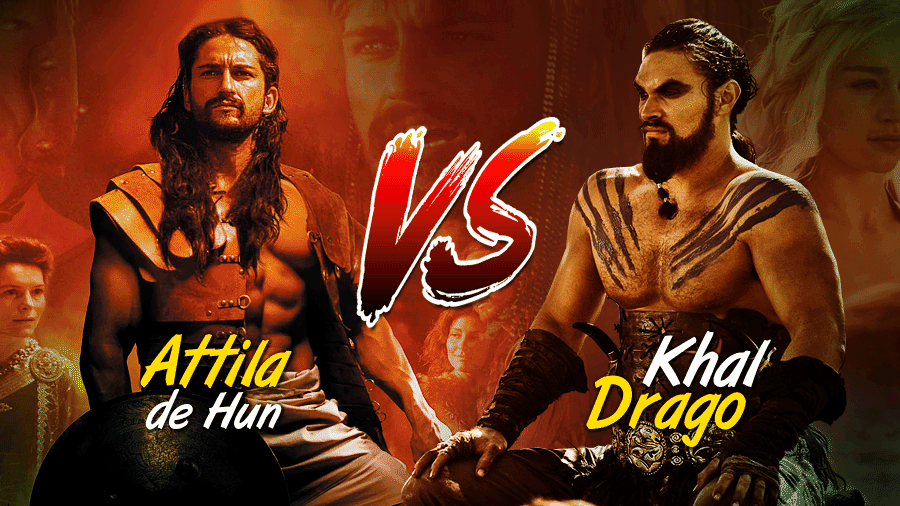Comparative essay example: “Khal Drogo and Attila the Hun”


A comparative essay is an essay that discusses similarities and differences between two or more items. Usually, the items being compared in an essay are related. For example, these may be authors of different novels or characters of different plays, politicians or civil rights activists or countries. Unrelated items are never discussed in comparative essays. For example, it is impossible to compare a country and a character in a play. Therefore, when faced with the task of comparing two related items, one should establish one’s basis for comparing the two items. For example, the basis for comparing two characters of different plays can be characters’ attitude towards love.
It is important to note that a basis for comparing items in comparative essays usually forms the thesis statement for these essays. Additionally, the basis for comparison can be single or numerous. For example, characters’ physique, leadership styles, cultures, and fighting styles can all form the basis of comparing two characters. Comparative essay writers should always develop a list of similarities and differences of items being compared based on their established basis for comparison. Such approach helps to guide and ease the process of writing the comparative essay. Below is an example of a well-written comparative essay. It compares two characters, Attila the Hun character and the Khal Drogo character.
Legends are told of great men who once walked this earth, conquered continents, did great deeds, and were comparable to the gods. Examples of such legendary men include Hercules, Alexander the Great, Julius Caesar, Xerxes of Persia, Khal Drogo, Attila the Hun, Napoleon, and many more. A common feature of all these men is that they were great warriors and military men. Additionally, they were leaders of their people. This essay focuses on two legendary characters, Attila the Hun character and the Khal Drogo character. It aims at identifying the similarities shared by these two personalities, and the differences that exist between them.
Example of a Comparative Essay on Attila the Hun and Khal Drogo
Attila the Hun was the ruler of the Hunnic empire between 434 and 453 AD. During the time of his rule, the Hunnic empire stretched from Central Europe to Eastern Europe. The empire was mainly made of the Huns, the Alans, and the Ostrogoths. Today historians have not yet answered all questions on Attila’s death, especially the question “How did Attila the Hun Die?” On the other hand, Khal Drogo was a warlord of the Dothraki people. He led the largest Khalasar, made of 40 thousand strong Dothraki, who occupied the area around the Dothraki Sea and the continent of Essos. Khal Drogo’s death is well documented. There are many similarities shared by Attila the Hun and Khal Drogo. There are also significant differences between Attila the Hun and Khal Drogo. Such similarities and differences are identified in the analysis of their leadership, exploitation of military strength, reality, physique, and wars, which are discussed in detail below.
Similarities
Attila the Hun and Khal Drogo were both leaders of nomadic peoples who rode on horses. The Huns, whom Attila led, were nomadic people who roamed Asia, Eastern Europe, and Central Europe. The Huns raided the villages and cities that they passed through within these regions. Similarly, the Dothraki people, who Khal Drogo led, were nomadic people who roamed the continent of Essos to the Dothraki Sea. They also raided villages and cities which they passed through within the continent of Essos.
Additionally, Both Attila the Hun and Khal Drogo exploited their military strength to demand tributes in the form of gold, trade, and residences from their neighbors. In 439 AD Attila and his brother Bleda negotiated a treaty with the Romans, known as the Treaty of Margus. In this treaty, the Rome was to pay money or tribute in the form of gold to prevent Attila and the Huns from invading their territories. Similarly, Khal Drogo and the Magisters of Pentos negotiated an agreement in which the Magisters of Pentos offered Khal Drogo a 9-towered manse, which was situated in the bay of Pentos, as a tribute that served to distract him from the thoughts of invading Pentos.
Moreover, Attila the Hun and Khal Drogo both feared water. During the time when Attila and his men were raiding the Roman Empire, many people fled to swampy areas and islands to escape Attila’s scourge and ruthlessness, which led to the development of settlements around water, such as Venice. Attila and his men never followed the fleeing people in such areas. Similarly, Khal Drogo and his men feared the sea. In fact, it was a reason why Vyserys Targaryen found it difficult to raise an army of the Dothraki to help him reclaim the Iron Throne. Khal Drogo also resisted the idea of going to Westeros simply because it was located across the sea. However, he reconsidered the idea when an assassin attempted to kill dear wife, Daenerys Targaryen, an heir to the Iron Throne.
Differences
As much as Attila the Hun and Khal Drogo shared some similarities, there were also significant differences between these two characters. One of the major differences between these two characters is that Attila the Hun was a real-life character while Khal Drogo was a fictional one. Attila the Hun lived between the late 4th century CE and 453 CE, when he died. On the other hand, Khal Drogo was a fictional character created by a novel series known as A Song of Ice and Fire. Everything about Khal Drogo is fictional, including the Dothraki people, Pentos, and Essos. It is unknown who the Dothraki people are and where Essos, Pentos, and the Dothraki Sea are situated.
Additionally, both Attila the Hun and Khal Drogo differed in their physique. Attila the Hun is portrayed by historians as a short man who had a broad chest, big head, small eyes, and a thin beard. On the other hand, Khal Drogo is portrayed as a tall, muscular man with a long drooping mustache.
Finally, the other significant difference between Khal Drogo and Attila the Hun is that Khal Drogo was never defeated in war till his death, while Attila the Hun suffered some defeats in his encounters with the Romans and the Sasanians. The last battle Khal Drogo fought was against Khal Ogo, whom he defeated and killed. However, Khal Drogo had suffered a wound in his chest from the duel, that ultimately led to his death. On the other hand, Attila suffered his first defeat in a war against the Sasanians, who beat his army and drove the invaders back to their home, the Hungarian plains, around 439 AD. The next defeat that Attila suffered was in the Battle of Chalon, where the Romans defeated his army and stopped its advance towards Europe.
Conclusion
This paper has presented concrete evidence that supports similarities and differences that existed between Attila and Khal Drogo. Another significant similarity or difference could be drawn if the question “How did Attila the Hun die?” is accurately answered. Khal Drogo was killed by his wife, and some historians suggest that Attila was also murdered by his wife. Until the question is answered, readers must only rely on solid similarities and differences discussed above.